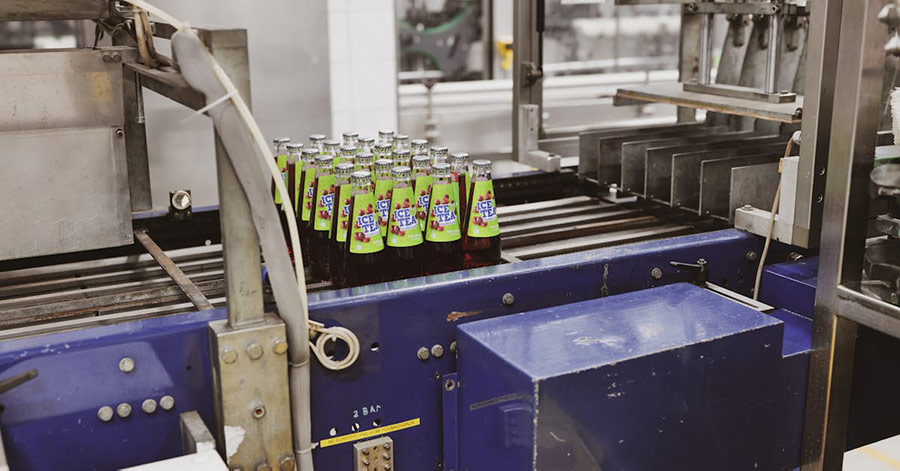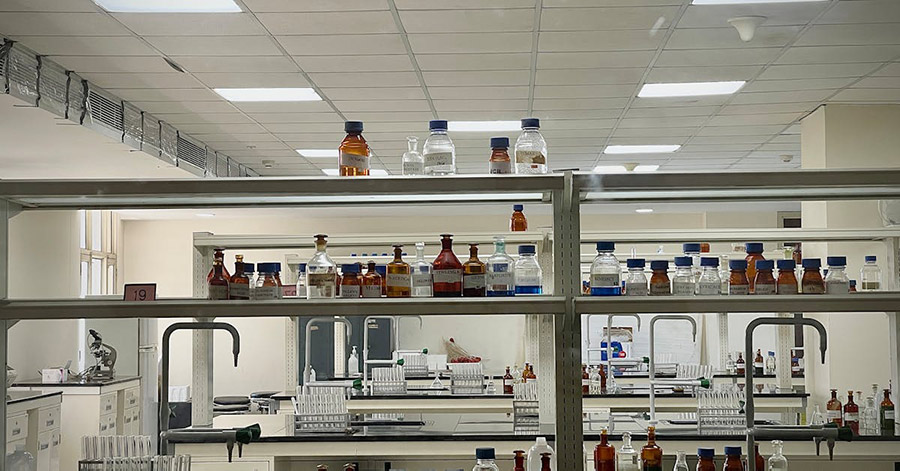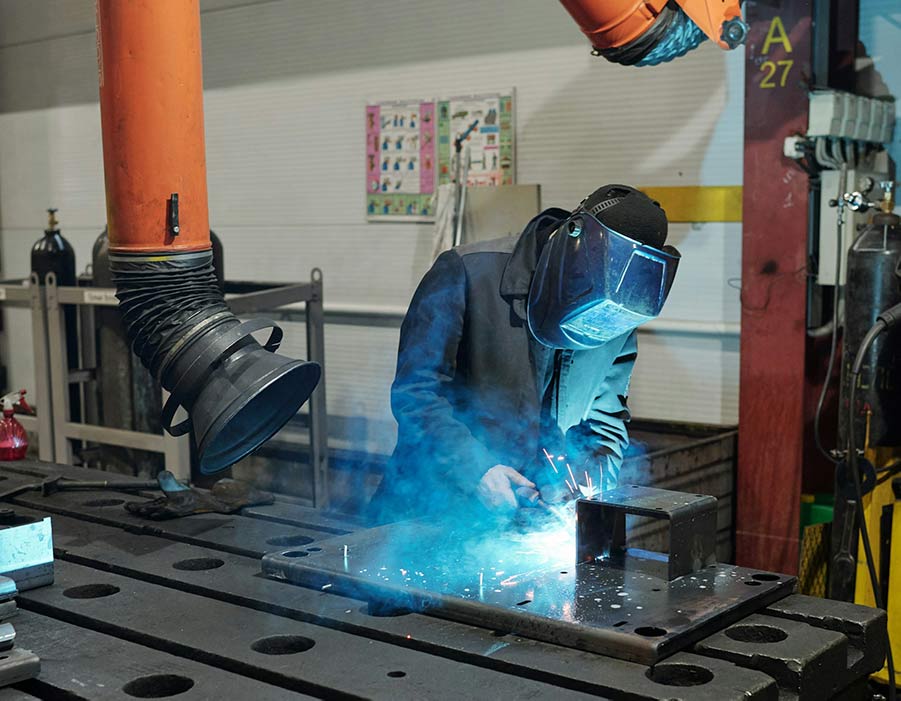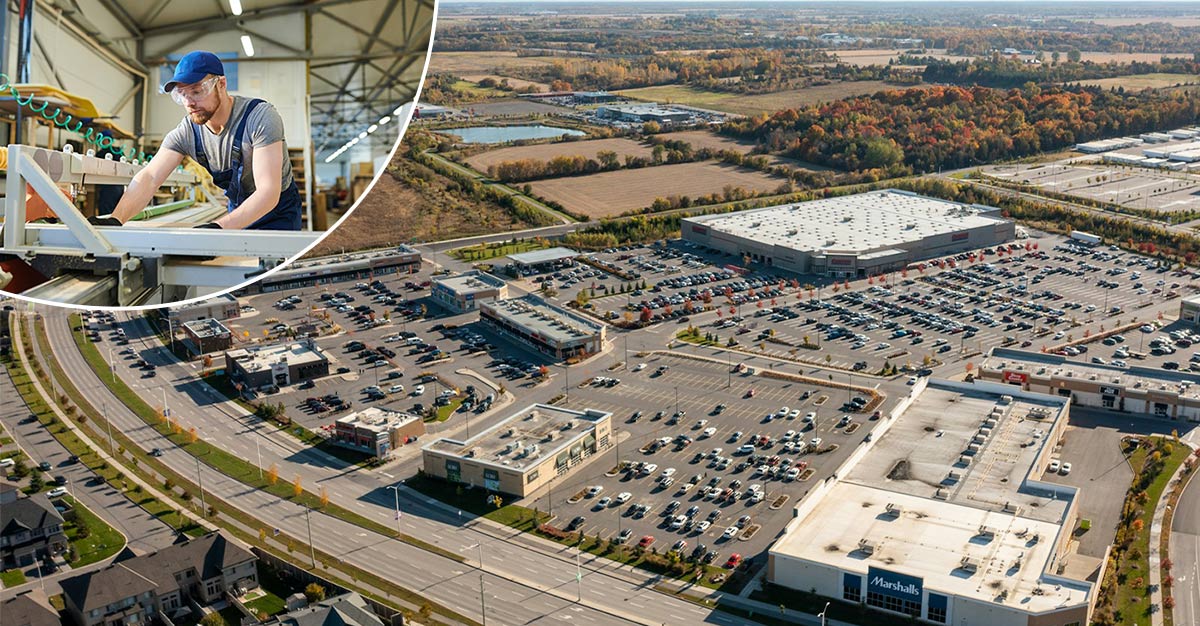Industrial plant design prioritizes creating a safe and secure workplace environment. This involves for instance fire safety protocols, electrical hazard mitigation, proper chemical handling, effective lighting systems, good ventilation and initiatives promoting workplace well-being. By integrating these considerations into the design process, industrial facilities can offer a safer and healthier workplace.

Industrial plant design – How to plan for a safe workplace
In the realm of industrial plant design, creating a safe and conducive workplace environment is paramount. A well-designed facility not only enhances productivity but also safeguards the health and well-being of workers. This article delves into key aspects of industrial plant design, focusing on workplace environment and security considerations such as fire safety, electrical safety and more.
Electrical safety
Electrical safety is of utmost importance in industrial environments to mitigate the risk of workplace accidents and injuries. By adhering to stringent standards and implementing comprehensive safety measures, industrial plants can ensure the protection of personnel and equipment.
Electrical codes and standards
Compliance with established electrical codes and standards is fundamental to maintaining a safe working environment. Industrial facilities must adhere to regulations such as the National Electrical Code (NEC) and Occupational Safety and Health Administration (OSHA) standards, which outline requirements for electrical installations, equipment, and workplace safety practices.
Grounding of electrical systems
Effective grounding of electrical systems is essential to prevent electrical shocks and fires. Grounding ensures the safe dissipation of electrical faults and reduces the risk of voltage surges. Industrial plants should employ proper grounding techniques for electrical equipment, machinery, and conductive structures, following industry best practices and manufacturer guidelines.
Insulation and protective devices
Insulation and protective devices play a crucial role in safeguarding against electrical hazards. Employing insulation materials rated for specific voltage levels, utilizing circuit breakers, fuses, and ground fault circuit interrupters (GFCIs), and implementing residual current devices (RCDs) help detect and mitigate electrical faults, preventing potential injuries or fatalities.
Inspections and maintenance
Routine inspections and maintenance are vital to ensuring the integrity and reliability of electrical equipment and systems. Industrial plants should schedule periodic inspections by qualified electricians to identify and address any potential hazards, such as loose connections, worn-out insulation, or overheating components. Timely maintenance interventions can prevent equipment failures and reduce the likelihood of electrical incidents.
Fire safety in industrial plant design
Fire safety stands as an important concern, requiring meticulous planning and implementation of robust measures to mitigate risks and safeguard personnel and assets. Here are some key considerations and strategies for ensuring fire safety in industrial facilities:
Storage of flammable materials
Effective fire safety begins with the proper storage and handling of flammable materials within the industrial plant. Segregating flammable substances from ignition sources, utilizing designated storage areas equipped with appropriate containment measures, and ensuring proper ventilation to prevent the buildup of flammable vapors are essential practices.
Installation of fire detection
Critical to early fire detection and containment, industrial plants must be equipped with advanced fire detection and suppression systems. This includes the installation of smoke detectors, heat sensors, and automated fire suppression systems such as sprinklers or foam suppression systems. Regular testing, maintenance, and calibration of these systems are imperative to ensure their reliability and efficacy.
Maintenance of fire exits
Unobstructed and well-maintained fire exits and evacuation routes are vital for facilitating swift and safe evacuation in the event of a fire emergency. Regular inspection and maintenance of exits, ensuring clear signage, adequate lighting, and accessibility for all personnel, including those with disabilities, are essential aspects of fire safety planning.
Regular fire drills
Practice is key to preparedness. Industrial facilities should conduct regular fire drills to familiarize employees with emergency procedures, evacuation routes, and the operation of firefighting equipment. These drills serve to enhance response times, minimize panic, and ensure coordinated efforts in the event of an actual fire incident.

Safety measures around chemicals
Handling hazardous chemicals poses inherent risks in industrial settings, necessitating robust safety measures to protect personnel and the environment.
Storage and handling procedures
Industrial plants must adhere to strict protocols for the storage, handling, and disposal of hazardous chemicals. This includes categorizing chemicals based on their properties and compatibility, utilizing appropriate containers and labeling systems, and segregating incompatible substances to prevent hazardous reactions. Implementing comprehensive inventory management systems and conducting regular inspections ensure compliance with regulatory requirements and minimize the risk of accidents or spills.
Personal protective equipment (PPE)
Proper selection and use of personal protective equipment (PPE) are essential for minimizing the risk of exposure to hazardous chemicals. Industrial plants should provide employees with appropriate PPE, such as chemical-resistant gloves, goggles, face shields, protective clothing, and respirators, based on the specific hazards present in their work environment. Training on the proper use, maintenance, and disposal of PPE is also essential to ensure its effectiveness in protecting workers from chemical exposure-related injuries and illnesses. Regular inspections and replacement of damaged or worn-out PPE further contribute to maintaining a safe working environment. By prioritizing the use of PPE, industrial plants can significantly reduce the potential health risks associated with chemical handling operations and enhance overall workplace safety.
Safety showers and eyewash stations
Industrial plants should strategically install safety showers and eyewash stations in close proximity to areas where chemical handling occurs. According to industry standards, safety showers and eyewash stations should be located within a 10-second walk from the hazardous area. This ensures easy and immediate access for personnel in case of emergencies, minimizing response time and potential injuries.
Safety showers are designed to provide a continuous flow of water over the entire body to dilute and rinse off chemicals from the skin and clothing. These fixtures typically include pull handles or levers for activation, allowing individuals to quickly initiate the flow of water in case of exposure. The water flow rate and temperature should meet regulatory requirements to ensure effective decontamination without causing thermal shock to the user.
Read more: www.giapremix.fi/hatasuihkut/
Lighting in industrial plant design
Lighting plays a pivotal role in creating a safe and productive work environment within industrial plants. By optimizing illumination levels and leveraging innovative technologies such as IoT LED lighting, industrial facilities can enhance safety, efficiency, and energy savings. Here are key considerations for lighting in industrial settings:
Adequate illumination levels
Ensuring sufficient lighting levels is crucial for promoting safety and minimizing workplace hazards. Properly illuminated work areas reduce the risk of slips, trips, and falls, while also facilitating accurate visual tasks and operations. Industrial plants should conduct lighting assessments to determine appropriate illumination levels for different tasks and areas, considering factors such as task complexity, ambient light conditions, and worker visibility requirements.
Tailored lighting solutions
Customizing lighting solutions to specific tasks and areas within the plant enhances efficiency and effectiveness. Task-specific lighting fixtures, such as task lights or area lights, can be strategically deployed to provide targeted illumination where it is needed most. Additionally, implementing zoning or dimming controls allows for flexible adjustment of lighting levels based on activity requirements, optimizing energy usage and worker comfort.
Integration of IoT LED lighting
The integration of Internet of Things (IoT) technology with LED lighting systems offers advanced capabilities for monitoring, control, and optimization. IoT-enabled LED fixtures can be equipped with sensors and networking capabilities to collect real-time data on lighting performance, occupancy patterns, and energy consumption. This data can then be analyzed to identify areas for improvement, optimize lighting schedules, and enhance overall operational efficiency.
Employing energy-efficient lighting fixtures is essential for reducing energy consumption and operating costs. LED lighting technology offers significant energy savings compared to traditional lighting sources such as incandescent or fluorescent bulbs. Industrial plants should prioritize the adoption of LED fixtures throughout their facilities, taking advantage of their long lifespan, low maintenance requirements, and superior energy efficiency.
Incorporation of natural lighting
Harnessing natural lighting wherever feasible not only reduces energy usage but also promotes employee well-being and productivity. Incorporating skylights, windows, and light wells into the design of industrial facilities allows for the ingress of natural daylight, supplementing artificial lighting sources and creating a more comfortable and visually appealing work environment.
Maintenance and upkeep
Routine maintenance and upkeep of lighting systems are essential to ensure optimal performance and longevity. Industrial plants should establish scheduled maintenance protocols, including tasks such as cleaning fixtures, replacing worn-out bulbs or components, and inspecting electrical connections. Proactive maintenance helps prevent disruptions, maintain lighting quality, and extend the lifespan of lighting assets.
More on this topic: www.iotled.net/iot-smart-lighting-system/

Effective ventilation systems
Effective ventilation systems are indispensable in industrial settings, serving to mitigate exposure risks to hazardous fumes and airborne contaminants. Whether in welding operations or chemical handling areas, proper ventilation plays a critical role in safeguarding workers’ respiratory health and ensuring compliance with regulatory standards. Here’s how industrial plants can optimize ventilation systems for enhanced safety and health:
Control of welding fumes
Welding operations generate hazardous fumes and particulates that pose respiratory hazards to workers. Implementing effective ventilation systems, such as local exhaust ventilation (LEV) and fume extraction hoods, is essential for removing welding fumes at their source. By capturing contaminants directly at the point of generation, these systems prevent their dispersion into the surrounding air, minimizing exposure risks and protecting workers’ respiratory health.
Control of hazardous chemicals
Ventilation systems also play a crucial role in controlling exposure risks associated with hazardous chemicals. Industrial plants should install and maintain ventilation systems capable of capturing and removing airborne contaminants at the source. Local exhaust ventilation (LEV) systems, fume hoods, and ducted ventilation systems are commonly used to ensure adequate air quality and protect personnel from inhalation hazards.
More info here: https://nordicinformer.com/emergency-shower-signs/
Routine inspection
Regular inspection and maintenance of ventilation equipment are paramount to ensure optimal performance and compliance with regulatory requirements. Industrial plants should establish comprehensive maintenance protocols, including periodic inspections, filter replacements, and equipment testing. Proactive maintenance helps identify and address issues promptly, ensuring the continued effectiveness of ventilation systems in controlling exposure risks.
Adherence to regulatory standards
Compliance with regulatory standards and guidelines is essential for ensuring the effectiveness and safety of ventilation systems. Industrial plants must adhere to regulations such as the Occupational Safety and Health Administration (OSHA) standards and local environmental regulations governing air quality and workplace safety. By staying abreast of regulatory requirements and industry best practices, plants can ensure that their ventilation systems meet or exceed safety standards.
Training for workplace safety
Comprehensive training programs are essential for ensuring the safety of personnel in industrial environments. These programs cover various aspects of workplace safety, including hazard identification, emergency response protocols, proper use of personal protective equipment (PPE), and safe handling practices for equipment and materials.
Hands-on exercises and simulations allow employees to practice emergency response procedures in a controlled environment, enhancing their preparedness for real-life scenarios. Tailoring training to specific job roles ensures that personnel receive relevant information and skills training based on their responsibilities.
Regular refresher training sessions are conducted to review key concepts, update procedures, and address emerging hazards. Documentation of training activities ensures compliance with regulatory requirements and helps track personnel’s proficiency in safety practices.
Workplace well-being in industrial plant design
Fostering a positive workplace environment goes beyond physical safety measures. Prioritizing employee well-being encompasses aspects such as ergonomic design of workstations, promoting work-life balance, providing access to wellness programs and mental health support resources, and fostering a culture of open communication and mutual respect. Investing in employee well-being not only enhances morale and job satisfaction but also contributes to overall organizational success.


